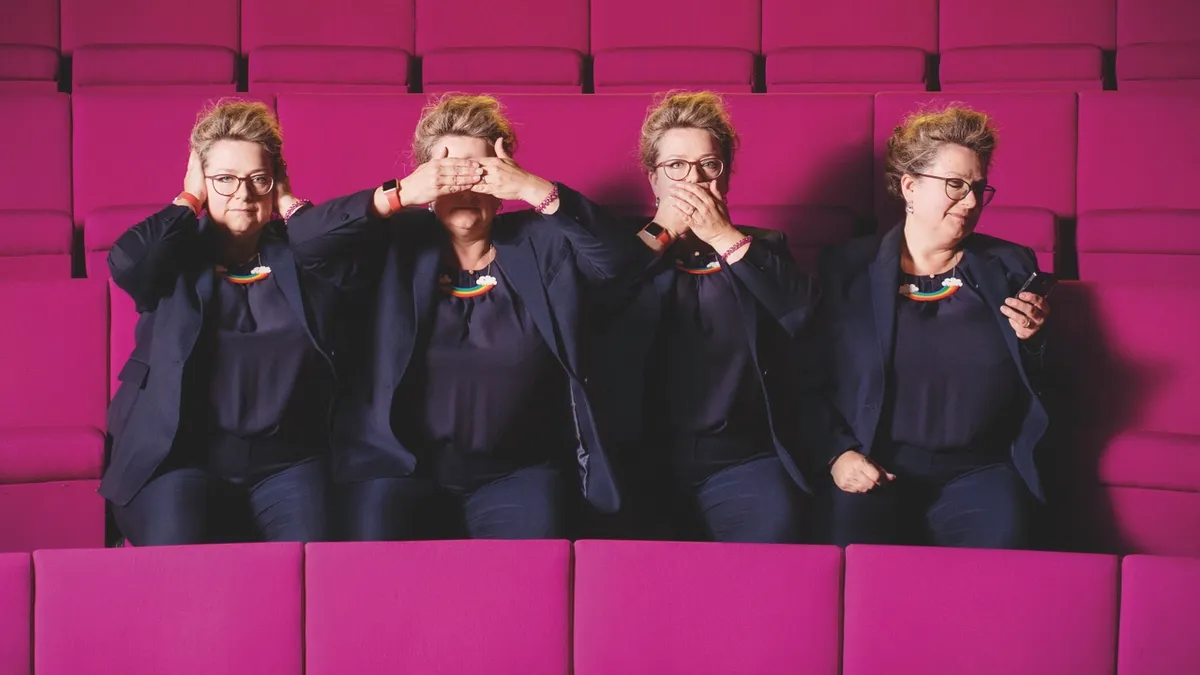Words, contrary to what the Bee Gees might have sung, aren’t all we have. From our body language to our facial expressions, we communicate in myriad ways. Neuroscientist Professor Sophie Scott is a communication expert, and in this year’sRoyal Institution Christmas Lectures, she’ll be looking at the language of life in all its forms, from the strange science of laughter to how technology is transforming the way we interact:
How much of our communication is linked to the actual words we speak?
Words are a critical part of communication, but there are many other ways in which we express ourselves. Take the voice itself, for example. You can’t see me right now, but you could have a good guess at my age, geographical origins, mood and health, all from the way I’m talking. Our voices change throughout our lives. As women go through the menopause, for instance, their voices tend to get lower in pitch, while men’s voices get higher as they age. There are social and cultural factors, too. Prior to puberty, boys and girls should theoretically speak at the same pitch because they’re the same size, but we find that boys speak with lower voices – they’re already picking up characteristics from the men around them.
And we communicate with our bodies as well, don’t we?
Yes, we use our facial expressions, eye movements and body language. A lot of this is intuitive and outside our awareness: after a conversation, you tend to remember the gist of what’s been said, but it can be harder to pull out the subtler things going on. You can train yourself to pick up on people’s transient facial expressions, but a lot of communication is down to the other person’s interpretation of the interaction.
Can we train ourselves to use body language more effectively?
It must be possible, because if you look at actors, dancers and singers, they learn to use their bodies in an authentic way: you believe in their performance. But with people who’ve had a bit of body language training, it’s like we can see their effort. It’s the same with bad acting. We’re so good at using these cues to work out someone’s state of mind that as soon as something’s not quite right, we pick up on that lack of authenticity.
Laughter is something else we often fake. How do you spot a fake laugh?
If you think back to the last time you couldn’t stop laughing, that’s the most spontaneous kind of laughter. You just have to let it work its way through – you’re lost to the laughter for a while. If the laughter stops and starts quite quickly, then it’s being used more communicatively. But this more controlled type of laughter is a useful social skill. We can use it to change a mildly difficult situation into a positive, safe one.

Why did laughter come about in the first place?
We’re not the only animals who laugh. We see it in rats – they make a kind of ultrasonic squeaking when tickled – and great apes, and there’s probably more out there too. Wherever we’ve found laughter, it’s associated with babies being tickled by their parents, so its initial role seems to be in social bonding. It may be an invitation to play – a way for animals to learn and explore social roles without getting hurt. It’s the same for adult humans. We think we’re laughing at jokes and humour, but we’re laughing just as much for social reasons, to show that we like and agree with the people we’re with.
What impact is modern technology having on communication?
There have always been ways to communicate that aren’t face-to-face. My grandparents’ generation lived at a time when the post was so quick they could have a conversation using postcards! We’re very good at exploiting new technologies to help us share messages. One of the first things we did with mobile phones was to send text messages, which no one saw coming. There’s some data from [evolutionary psychologist] Robin Dunbar’s lab which shows that face-to-face interaction – live or on-screen – leads to people feeling happier and laughing more than just listening to each other, and then the happiness drops off again for text-based interactions. But this study was done a few years ago, and I wonder if that’s changed now with all the ways we use GIFs and emojis. Whatever happens, I think communication is always going to be rooted in face-to-face interaction, because that’s how we learn to use speech as we grow up.
Can emojis ever be an effective way to communicate?
We have a long history of using punctuation to change the emotional tone of our writing, and that’s just what we’re doing with emoticons and emojis. We’re not going to be comfortable sending emojis to everyone – I’m unlikely to start sending messages full of them to the dean of my university – but they can show you things you didn’t know you needed. I was struck by the number of emojis for approval: the 100 per cent sign, OK fingers, clapping hands, thumbs up. It’s great – I can give somebody feedback without having to write a long essay on why I thought that was a funny tweet.
What do you hope your audience will take away from your lectures?
I hope I’ll be able to do justice to the sheer complexity of communication, from basic signals like “I’m a dangerous wasp” through to the possibilities of the human voice. And one of the really powerful things about the Christmas Lectures is that they can show there are all these different ways of being a scientist. Male, female, younger, older – there’s not just one way of doing it or one route to getting there. Hopefully that’ll help to shift some of the stereotypes.
Listen to our full interview with Sophie Scott in the Science Focus podcast
Follow Science Focus onTwitter,Facebook, Instagramand Flipboard
